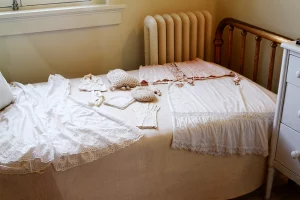
If you love hunting for vintage clothes, you certainly are used to going around second-hand shops and garage sales. Those places have a lot of hidden gems that are simply waiting for you to find them and give them new life. Second-hand clothes can be extremely inexpensive; if you find a well-maintained designer piece, you should take advantage of it.
However, second-hand clothes have already been worn by other people so you should disinfect and wash them once you bring them home. If you find brand-new garments, you should also wash them to eliminate excess dyes and other chemical treatments.
If the piece of clothing has a funny smell, mould and mildew may be present. Follow the cleaning methods listed below to properly clean your vintage clothing and be able to enjoy it.
The good news is that the thorough cleaning of vintage clothing is very similar to the regular washing of clothes. Most of the products mentioned in this article are probably already in your pantry.
Here are the steps you should follow when cleaning second-hand clothing
- Always read the fabric care label – Check for a label before buying the item. It will identify the fibres of the fabric and show you any specific requirements for the cleaning of those garments. Make sure you follow them to avoid damage and discolouration and achieve the best possible results.
- Dry cleaning – It is best to bring all of the ‘’dry cleaning only’’ items to a professional dry cleaner. Avoid using a home dry cleaning kit since vintage fabrics may be fragile or have specific needs you do not know of. If you just bought a garment, bring it to the dry cleaner. If there are any stains, the professional can determine if they can be removed and will know how to do that in the best way.
- Hand washing – Hand washing is the most secure method of cleaning washable second-hand clothing for the first time. If the garment’s tag reads “wash separately before wearing,” expect some dye transfer and colour bleeding if the garments are brand new. Hand washing will help remove some of the extra dye, but check the rinse water. If the colour persists in the water, wash the item separately or with similar colours in the future. It may take several washes to remove the extra dye and protect other clothes.
- Treat stains – If the vintage garment has stains, treat them right before washing the item. Grab an enzyme-based laundry detergent and apply a bit on the stained area. Gently rub it in with your fingers or a soft-bristled brush. Let it sit for about 10 minutes, then rinse and wash the garment.
- Sanitise (optional) – Dry cleaning or washing If you dry the item in a high-temperature automatic dryer, the garment will usually eliminate any insects or bacteria that have remained on the fabric. However, if you want to add another step to the sanitisation process, use a laundry sanitiser
The label will tell if the fabric can be machine-washed or if it is for ‘’dry cleaning only’’. If only dry cleaning is suitable for the fabric, do not attempt cleaning it at home.
Follow a laundry routine that includes pretreating stains, sorting garments by colour and fabric type, using an enzyme-based laundry detergent, paying attention to water temperatures, and utilising the appropriate washer and dryer cycles.
To remove strong odours
Sometimes, second-hand clothing (even if brand new) may have a strong odour. This is usually caused by chemicals, perfumes or musty storage. Wash the fabric and see if the bad smell goes away. If the smell persists after washing, soak the item overnight in a sink or bucket filled with lukewarm water and 1 cup of baking soda before washing again. To assist remove any detergent or fabric softener residue in the fibres that may be clinging onto the aroma, add 1 cup of distilled white vinegar to the rinse cycle.
Extra tips on care, repairs, and other maintenance for second-hand clothing:
- Any stitching or repairing should be done before washing since the agitation of the washing machine and dryer action can unravel loose seams or tears. Inspect the clothing again right after drying to ensure that no new damage has occurred.
- Never put second-hand clothing aside without first properly laundering it. Though it is uncommon, vintage clothing has been known to harbour moths, bedbugs, or even diseases, which can be passed on to other garments if not removed. Unless you clean it before storing it, that beautiful wool sweater from a flea market could be harbouring moths that will start eating other wool items in your closet.
- If you are concerned about hygiene, have used clothes dry cleaned the first time you clean them. Perchloroethylene, one of the chemicals used in dry cleaning, is extremely good at removing germs and bacteria.
